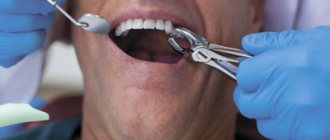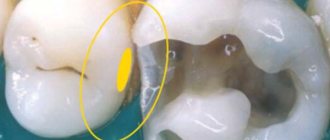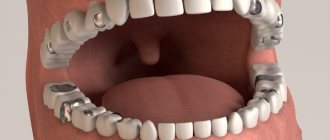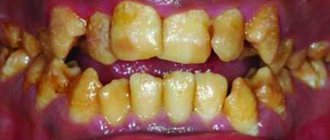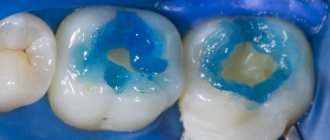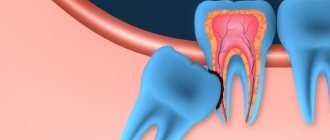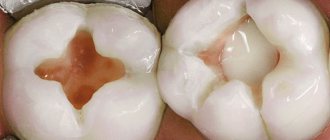Publication date: 03/30/2021
The absence of incisors affects the aesthetics, speech, diction and self-confidence of any person.
Incisors are teeth in the frontal zone. These include four upper and four lower elements. The two central ones are called units, the ones next to the canines are called twos or lateral teeth. They have one root and a cutting flat crown. They perform the function of cutting and biting food. And, of course, they decorate us when we smile and laugh.
In modern dentistry there are several methods to eliminate this problem, restoring a beautiful smile, healthy teeth and good mood.
Absence of incisors and effective techniques for correcting the situation
The absence of incisors and any other teeth in dentistry is called adentia. Congenital and acquired adentia are noted. Partial is common, but complete congenital is extremely rare. Losing all teeth is more often the fate of older people, when the functioning of the immune system and the body as a whole slows down, and a gradual loss of a large number of elements occurs.
The upper incisors are more often absent than the lower ones; the reason for this is still unknown.
If there are no incisors, this does not mean that you can leave it like that; it is better to contact a professional dentist in the clinic and correct the defect. Regardless of whether it is congenital or due to injury, unsuccessful treatment, or even an advanced disease.
There are effective techniques that can offer a solution to the problem of missing incisors:
- Orthopedic. An orthopedic dentist will offer prosthetics - crowns, bridges, microprostheses, implants;
- Orthodontic. The orthodontist determines the type of structures and braces that will help move the existing teeth to the place of the missing ones.
Each of the proposed treatment methods will help make the absence of jaw incisors invisible or replace them with artificial analogues. In no way inferior to natural teeth.
Clinical picture
The term used in dentistry to describe the absence (loss) of teeth, including incisors, is adentia.
Based on the time of occurrence, this pathological condition is usually divided into two forms - primary or secondary.
The first form of adentia is usually congenital, and its primary signs are detected in children using radiography.
The photograph demonstrates the absence of rudiments and the presence of trema (space between already erupted elements). The phenomenon is diagnosed in 1 in 100 babies and can be asymmetric or symmetrical.
Important: the peculiarity of the primary form of adentia is the absence of any negative sensations in the child.
The lack of incisors does not cause any special problems, other than aesthetic ones. If edentia is left unattended, problems with the gastrointestinal system, pronunciation, and psychological complexes may also arise in the future.
Secondary adentia develops due to the loss of incisors after their eruption due to a number of circumstances. The long-term absence of elements of the frontal area causes increased abrasion of the enamel coating (hyperesthesia).
Difficulties with eating and facial asymmetry (when soft tissues “sink” in the area of the cheeks and lips) may also occur. The consequence of all of these conditions is a deterioration in human health and quality of life.
What dangers await patients with missing incisors?
Edentia of any tooth is an imbalance in the entire dental system, including the absence of lateral, upper, and lower incisors, regardless of location. The problem cannot be put off for long. Otherwise, you may encounter negative consequences such as:
- increased load on other teeth, which leads to rapid wear of the enamel, the possibility of cracks, and bone tissue atrophy;
- traumatic occlusion, when when closing the jaws, the periodontal tissues are overloaded, which even causes loosening of the teeth and their mobility;
- displacement of teeth due to the fact that there is no incisor on the opposite jaw; the tooth that has lost support begins to shift, just like the neighboring ones. The bite changes and joint changes in the jaw occur;
- functional disorders. The absence of incisors contributes to improper biting of food, swallowing, speech impediment, splashing of saliva during a conversation;
- Bone tissue atrophy due to insufficient load begins to develop 3-6 months after the removal of the incisors. Volume loss becomes an indication for bone grafting during planned implantation;
- change in a person’s appearance: in the absence of upper incisors, the soft tissues of the lip recede, the proportions of the face change with greater edentia, and if there are no lateral teeth, large gaps and cracks appear between the elements of the frontal row.
Reasons for absence
In practice, there are clinical cases where the front teeth are missing from birth - this is called the primary absence of incisors. More often in a child these are doubles of the upper jaw, usually in pairs - on both sides. If only one incisor is missing, then the second is most likely small and underdeveloped. If it is not detected during a simple examination, it can be seen in the jaw bone on an x-ray.
At 6-7 years old, the child begins to change incisors; if new teeth have not appeared, edentia occurs.
Why are the incisors missing:
- heredity;
- a violation of intrauterine development, when during the formation of the germ of teeth in the embryo, something went wrong: the woman’s illness, taking serious medications;
- serious childhood diseases, including genetic ones;
- endocrine disorders, hormonal imbalances;
- untreated baby teeth;
- taking medications;
- lack of vitamins, minerals, metabolic disorders.
Secondary absence of incisors occurs in adults in case of injury, untimely treatment of caries, pulpitis, cysts and other diseases (including gums) that destroy the tooth. When the doctor is forced to remove an incisor. Another reason may be unprofessional treatment and poor-quality implantation.
Symptoms and manifestations of edentia
The main symptom of edentulous incisors is their absence in the dentition.
At the same time, they can have an impacted form - be in the bone or gum. This can only be seen on x-ray diagnostics.
Most often, people turn to the dentist in the absence of lateral incisors - twos. Due to the resulting empty space, neighboring elements, fangs, are displaced. Such defects appear as cracks (cracks), malocclusion, deterioration of speech (lisp, whistling during a conversation).
And there are unique cases when a person does not even know that he is missing some teeth, believing that everything is normal. Only on an X-ray image does he see his missing incisors in the bone tissue, which were never born.
Diagnostic specifics
The existence of adentia, its form, and the cause of its appearance are established by performing certain diagnostic measures:
- A detailed interview with the patient and study of his medical history . The doctor finds out the presence of the pathological condition in close relatives, the time of occurrence and the cause.
- Visual and instrumental inspection . The type of phenomenon is determined - single-multiple, symmetric-asymmetric. The parameters of the diastema, the condition of neighboring units, and the quality of pronunciation are assessed.
- X-rays. It is the main diagnostic method. Helps to accurately determine whether retention or absence of a tooth germ is the cause of incisor deficiency.
- No less informative is an orthopantomogram - a type of fluoroscopy that shows the condition of all teeth and the presence/absence of their rudiments.
Diagnosis allows not only to confirm the presence of a pathological condition, but also to determine circumstances that will not allow prosthetics or orthodontic therapy:
- Remains of tooth roots;
- inflammation;
- bone growths;
- stomatitis;
- tumor neoplasms;
- impacted units.
If necessary, an in-depth diagnosis is prescribed, including photometry, consultation with highly specialized specialists, and a study of the performance of the jaw joints.
Why milk teeth in adults may not fall out for a long time and why the anomaly is dangerous.
Come here if you are interested in the difficulties that arise during the period of mixed dentition.
At this address https://orto-info.ru/zubocheliustnye-anomalii/okklyuzii/chto-takoe-sindrom-kostena.html we will consider the main symptoms of Kosten syndrome.
Treatment methods
Orthodontic treatment method
The absence of incisors is dealt with by an orthodontist. There are several options for installing structures - braces, springs, rods:
- shifting the canine to the center, in place of the missing incisor. After its location there, the canine is shaped and adjusted to fit the lateral incisor. However, over time, a straight bite can form, which is a violation, leading to rapid abrasion of the enamel and disruption of the jaw joint;
- shift of the canine in the distal direction. By retracting the canine tooth toward the premolars, space is created for further implantation or prosthesis placement to fill the empty space.
Prosthetics.
After removing the incisors or creating enough space for prosthetics using orthodontic structures, the doctor chooses a method for restoring an artificial tooth.
Adhesive prosthesis
often used for anterior teeth. It is fixed to the adjacent teeth, in which special notches are made for its installation. The prosthesis is aesthetic, can withstand loads, but for its use it is necessary to exclude the presence of such factors as:
- bruxism
- mobility of supporting teeth
- severe decay of these teeth
- allergy to dental material
Filling material and veneers (Lumineers)
suitable in the absence of lateral incisors, when three gaps appear between the canine and the unit. The doctor can use a filling composite, placing it on adjacent teeth, building up and filling the space. Or use microprostheses - veneers, thin overlays that are glued onto the previously ground down surface of the tooth. Veneers and lumineers return aesthetics to the front row.
Veneers can also correct the shape of fangs after the orthodontist’s work, shifting them towards the incisors, turning them into snow-white “twos”.
Implantation
- one of the types of solution to the problem of the absence of lateral or anterior incisors. Once the site for the implantation of an artificial tooth root - an implant - has been prepared, a bed is made in the bone and gum, and installation takes place. After complete healing, the abutment and artificial crown are fixed.
The most reliable way to restore a missing incisor, but it has a number of contraindications, one of which is children under 18 years of age, while the bone is growing.
Duration of treatment
There is no quick way to correct the situation with the absence of an incisor. Unless it is immediate implantation after removal. In other cases, the work of an orthodontist is necessary to form a place for the future chosen prosthesis (a year or two). If it is a veneer, then its installation will take up to a week (until the individual microprosthesis is ready), the same with an adhesive bridge in time. Implantation depends on osseointegration of the artificial root. It may take several months. But this method of restoration lasts for many years; you only need to take care of the crown.
Reviews
Congenital edentia of the incisors is a relatively rare anomaly; the vast majority of people, fortunately, do not experience it.
But if you find yourself among nature’s “chosen ones” and have experienced this problem personally, share your experience of getting rid of it with visitors to our site. Leave your comment at the bottom of the page.
If you find an error, please select a piece of text and press Ctrl+Enter.
Tags: bite correction
Did you like the article? stay tuned
Previous article
FNTA is a worthy alternative to surgical treatment of complex distal occlusion
Next article
Kois deprogrammer in orthodontics or everything ingenious - simple
Table with clinics where to go to solve the problem of missing incisors
| braces | zirconium implant | veneers | |
| Ilatan | turnkey approx. 98,000 | 39 000 | 16 000 |
| StomDom | 85 000 | 26 000 | 22 000 |
| Implant Expert | 40 000 | 30 000 | 15 000 |
| All yours | 80 000 | 26 000 | 21 000 |
| Mendeleev | "Full construction" 177 000 | 25 000 | 13 000 |
Questions and answers
Please tell me how much basal implantation will cost in my case?
Good afternoon I am 51 years old and completely edentulous. Please tell me how much basal implantation will cost in my case? Thank you.
Hello!
The cost of complex basal dental implantation ROOTT in case of complete absence of teeth is 550,000 rubles. The price includes all manipulations for installing implants, metal-plastic prostheses, further examinations and corrections, and a guarantee. If there are any unremoved tooth roots remaining, then their removal in one step before implantation will also be included in this cost. In order to find out whether dental implantation is indicated for you, you need to undergo an examination. In our clinics, you can undergo an oral examination and get a consultation with an implant surgeon for free; based on the results of the consultation, a treatment plan will be drawn up with all possible options for restoring teeth in your case. To make an appointment, call us at +. Best regards, SIMPLADENT Patient Support Center + + 8 Other questions
Price
The multi-stage nature and variety of methods for treating edentulous incisors makes it difficult to predict the exact amount of expenses.
The total cost of treatment depends on the number and type of operations performed, the location of the clinic, and its status.
The table below shows the approximate cost of individual operations, which can be used as a guide when calculating the final amount.
| Cost, rub | ||||||
| Diastema closure | Installation of veneers | Direct veneering | Prosthesis on an implant | Implant installation | Butterfly prosthesis | Orthodontic stage |
| From 2500 | From 25000 | From 8000 | From 50000 | From 15000 | From 2000 | 150000 |

